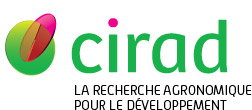Deleglise Hugo, Interdonato Roberto, Bégué Agnès, Maître d'Hôtel Elodie, Roche Mathieu, Teisseire Maguelonne.
2022. Natural Language Processing (NLP) methods to support satellite data interpretation in Early Warning Systems in West Africa.
. ESA, DLR
|
Version publiée
- Anglais
Accès réservé aux personnels Cirad Utilisation soumise à autorisation de l'auteur ou du Cirad. 612553_abstract.pdf Télécharger (129kB) | Demander une copie |
|
|
Version publiée
- Anglais
Accès réservé aux personnels Cirad Utilisation soumise à autorisation de l'auteur ou du Cirad. 612553_diaporama.pdf Télécharger (3MB) | Demander une copie |
Matériel d'accompagnement : 1 diaporama (19 vues)
Résumé : Food security in West Africa is considered as one of the major development challenges of the region. Food security issues are particularly prevalent there due to strong demographic growth, household food and subsistence based mainly on rain-fed agriculture and high rainfall variability. Added to these factors are the security and health risks facing the region, making agricultural production systems particularly fragile and fluctuating. Thus, the cyclical aspects of agricultural production are combined with those structural aspects of the vulnerability of populations. Since the major droughts of the early 1970s, several crop monitoring and food security early warning systems (EWS) have been developed in the region to enable decision-makers to anticipate crises, and to help plan emergency measures emergency by targeting populations and / or areas at risk. Since 2016, the GEOGLAM Crop Monitor for Early Warning (CM4EW) conducts a deliberative evidence-building process to reach an agreement on monthly crop conditions produced by the different EWS (Becker-Reshef et al., 2020). In these systems, satellite information is mainly used to derive vegetation index anomalies from time series of low spatial resolution images (MODIS or PROBA-V type), and precipitation data. Vegetation anomalies maps are produced from the NDVI value obtained for the current decade and compared to the average NDVI value for the same decade calculated over a reference period or what is assumed to be a normal situation. If satellite images remain the main source of information for EWS at national and regional scales, their use still raises a number of issues: (i) the observed discrepancy between vegetation anomalies produced by different crop monitoring systems (Lemettais L., 2021), while the basic satellite data are identical, and (ii) the detection of a vegetation anomaly in real time is not sufficient to establish a diagnosis on the agricultural production of a region because many factors come in consideration. To complete the information collected from the field, local newspapers and new media report certain climatic or socio-economic events which may partly explain the vegetation anomalies observed. These events are not all listed, but they provide qualitative (good development, stunted growth, etc.), diagnostic (drought, flooding, etc.) and localized information which is complementary to that of satellite images and field information. Thus, the hypothesis underlying our work is that textual data from newspapers and other media represent a still untapped resource that can be used, in combination with products derived from satellite images, to provide a more comprehensive framework on food security of a region. In this context, we aim to strengthen food security monitoring systems through the use of advanced Natural Language Processing (NLP) and data science methods. More specifically, in a context of a rapidly growing technological and scientific offer, the methodological objective of our work is to enrich the crop monitoring and early warning systems of West Africa, with information derived from the analysis. The applied objective is to provide additional information based on textual data coming from online media (e.g. newspaper). The proposed process is based on 3 stages (Figure 1). The first one consists of implementing different machine and deep learning approaches using heterogeneous data including satellite images in order to predict food security indicators (see step 1 - Figure 1). In order to address this issue, the FSPHD (Food Security Prediction based on Heterogeneous Data) framework is implemented and evaluated. To address the structural heterogeneity of the data, four groups of data are treated with adapted machine and deep learning methods, i.e. time series (NDVI, land temperature, rainfall, but also market prices), conjunctural data, thematic maps and data, and high spatial resolution (HSR) images. Different variants of the framework are experimented to obtain the final results. We observed the modest but significant contribution of deep learning models (convolutional neural networks - CNN) to HSR data processing. This work is detailed in Deleglise et al. (2021). The second part is dedicated to applying NLP approaches (Fize et al., 2020) for highlighting some textual data extracted in newspapers in West Africa (see step 2 - Figure 1). The last step consists of mapping these keywords (e.g. locust invasion, flood, terrorism) in order to propose contextual interpretations of results obtained with machine and deep learning approaches (see step 3 - Figure 1).
Mots-clés libres : Food Security, Media mining, Early warning, NLP, Heterogeneous data, GEOGLAM
Classification Agris : U60 - Sciences de la vie et de la Terre
Auteurs et affiliations
- Deleglise Hugo, CIRAD-ES-UMR TETIS (FRA)
-
Interdonato Roberto, CIRAD-ES-UMR TETIS (FRA)
 ORCID: 0000-0002-0536-6277
ORCID: 0000-0002-0536-6277
- Bégué Agnès, CIRAD-ES-UMR TETIS (FRA)
- Maître d'Hôtel Elodie, CIRAD-ES-UMR MOISA (FRA)
-
Roche Mathieu, CIRAD-ES-UMR TETIS (FRA)
 ORCID: 0000-0003-3272-8568
ORCID: 0000-0003-3272-8568
- Teisseire Maguelonne, INRAE (FRA)
Source : Cirad-Agritrop (https://agritrop.cirad.fr/612553/)
[ Page générée et mise en cache le 2025-09-28 ]




